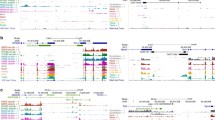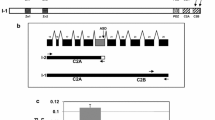Abstract
Genomic sequencing was combined with searches of databases for identification of active genes on human chromosome 22. A cosmid from 22q13, located in the telomeric vicinity of the PDGFB (platelet-derived growth factor B-chain) gene, was fully sequenced. Using an expressed sequence tag-based approach we characterized human (SYNGR1) and mouse (Syngr1) orthologs of the previously cloned rat synaptogyrin gene (RATSYNGR1). The human SYNGR1 gene reveals three (SYNGR1a, SYNGR1b, SYNGR1c) alternative transcript forms of 4.5, 1.3 and 0.9 kb, respectively. The transcription of SYNGR1 starts from two different promoters, and leads to predicted proteins with different N- and C-terminal ends. The most abundant SYNGR1a transcript, the 4.5-kb form, which corresponds to RATSYNGR1, is highly expressed in neurons of the central nervous system and at much lower levels in other tissues, as determined by in situ hybridization histochemistry. The levels of SYNGR1b and SYNGR1c transcripts are low and limited to heart, skeletal muscle, ovary and fetal liver. We also characterized two additional members of this novel synaptogyrin gene family in human (SYNGR2 and SYNGR3), and one in mouse (Syngr2). The human SYNGR2 gene transcript of 1.6 kb is expressed at high levels in all tissues, except brain. The 2.2-kb SYNGR3 transcript was detected in brain and placenta only. The human SYNGR2 and SYNGR3 genes were mapped by fluorescence in situ hybridization to 17qtel and 16ptel, respectively. The human SYNGR2 gene has a processed pseudogene localized in 15q11. All predicted synaptogyrin proteins contain four strongly conserved transmembrane domains, which is consistent with the M-shaped topology. The C-terminal polypeptide ends are variable in length, display a low degree of sequence similarity between family members, and are therefore likely to convey the functional specificity of each protein.
Similar content being viewed by others
Author information
Authors and Affiliations
Additional information
Received: 16 December 1997 / Accepted: 18 March 1998
Rights and permissions
About this article
Cite this article
Kedra, D., Pan, HQ., Seroussi, E. et al. Characterization of the human synaptogyrin gene family. Hum Genet 103, 131–141 (1998). https://doi.org/10.1007/s004390050795
Issue Date:
DOI: https://doi.org/10.1007/s004390050795




